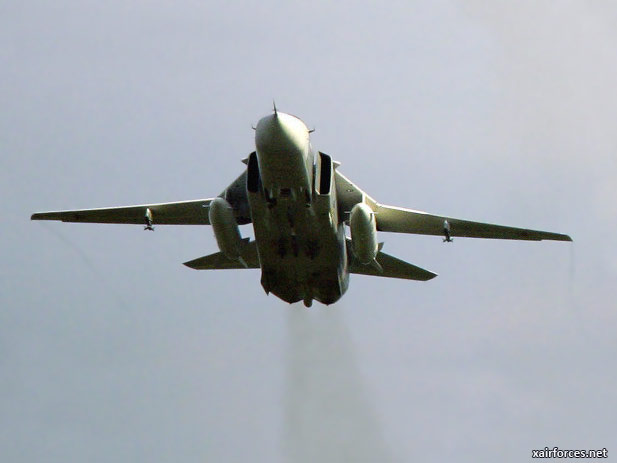
Su-24 Bomber Crashes in Urals - No Casualties

A Russian Air Force Su-24 Fencer tactical bomber crashed in the Urals region on Monday, the Defense Ministry said.
No one was hurt as the two pilots ejected safely in the Kurgan region.
The plane wreckage has already been found, a Defense Ministry official said.
Engine failure was the probable cause of the crash, the official said.
About Su-24M Fencer
The Su-24M front-line bomber is manufactured by the Sukhoi Design Bureau Joint Stock Company, based in Moscow, and the Novosibirsk Aircraft Production Association, Novosibirsk, Russia. The Su-24M entered service in 1983 and is a development of the Su-24, known by the NATO codename 'Fencer'.
Over 900 Su-24s have been delivered, and the aircraft is in service with the Russian Air Force and Navy, and the air forces of Azerbaijan, Algeria, Belarus, Kazakhstan, Libya, Syria and Ukraine.
The Su-24M front-line bomber is designed to penetrate hostile territory and destroy ground and surface targets in any weather conditions, by day and night. Variants of the Su-24 have also been produced, designed for reconnaissance and electronic countermeasures.
400 Russian Air Force Su-24M are being upgraded to M2 standard with navigation and weapons systems to enable launch of new versions of Kh-29 and other missiles. Upgrades include a new SV-24 computer, liquid crystal displays, ILS-31 head-up display, digital moving map and global positioning system. The Su-24 will be replaced in Russian Air Force service by the Su-35, beginning in 2010.
DESIGN
The aircraft has a conventional aerodynamic configuration with a variable-sweep shoulder wing. The fuselage is of rectangular-section semi-monocoque design, with a two-seat pressurised cockpit. The wing sweepback angle varies from 16° to 69°, with respect to the wing leading edge with four outer-wing panel fixed positions of 16°, 35°, 45° and 69°.
The tail unit comprises all-moving horizontal tail surfaces and a single-fin vertical tail fitted with a rudder. The horizontal tail surfaces function as an elevator when deflecting symmetrically, and as ailerons when deflecting differentially. Tricycle-type landing gear allows the aircraft to be operated from either concrete or unpaved runways.
WEAPONS
The Su-24 is armed with the following types of air-to-surface missiles: Kh-23 or Kh-23M (NATO codename AS-7 Kerry) radio-command guided missiles (range 5km; up to four missiles carried); Kh-28 (AS-9 Kyle) and Kh-58 passive radar-homing missiles (range 90km; up to two missiles carried). Up to two Vympel R-60 (AA-8 Aphid) IR-homing air-to-air missiles with a range of 3km are also carried.
The Su-24M aircraft is armed with: Kh-25L (AS-10 Karen) laser-guided missiles (range 20km; up to four missiles carried); Kh-29LT (AS-14 Kedge) laser / TV-guided missiles (range 10km; up to three missiles carried); Kh-31P (AS-17 Krypton) passive radar-homing missiles (range 180km; up to two missiles carried); and Kh-59 (AS-13 Kingbolt) TV-command-guided missiles (range 90km; up to two missiles carried).
It is also armed with KAB-50OKR TV-guided and KAB-1500L laser-guided air bombs, supplied by the Region State Research and Production Enterprise of Moscow.
Both aircraft can carry up to six rocket pods. The weight of conventional bomb armament amounts to between 7.5t and 8t.
The aircraft can carry up to three gun pods with 23mm Gsh-6-23 guns, which have a rate of fire of 9,000 rounds a minute and fire unit of 500 rounds. Gsh-6-23 guns are manufactured by the Instrument Design Bureau of Tula, Russia.
TARGETING
The Su-24 bomber's integrated navigation and aiming system is the PNS-24. PNS-24, in conjunction with radio navigation equipment, can perform the following functions: terrain warning; detection of targets and their destruction by level and toss bombing; target designation for missiles; detection of operating radars and launch of missiles on these radars; and automatic and semi-automatic aircraft control during landing approach to a height of 40m to 50m.
The Su-24M aircraft is equipped with the PNS-M modified integrated navigation and aiming system, which includes a laser/TV-sighting system for the air-to-surface laser/TV-guided missiles.
ENGINES
The power plant comprises two A-F turbojets, with a thrust of 11,200kgf each. Fuel is accommodated in fuselage integral tanks. Two external fuel tanks with a capacity of 3,000l each can be suspended from the centre-wing section, with one external fuel tank, with a capacity of 2,000l, suspended from the fuselage.
An inert gas system is installed for fire safety. The Su-24M aircraft is equipped with a flight refuelling system.
The Su-24M has a maximum speed of 1,550km/h and a range of over 3,000km. The service ceiling is 11,000m and the maximum rate of climb is 9,000m a minute.
Source: Moscow, 07 February 2012 - RIA Novosti Defence News (http://en.rian.ru)
Photo: The Russian Air Force Sukhoi Su-24 Bomber Aircraft (Photo by RIA Novosti )
(12.02.2012)
|